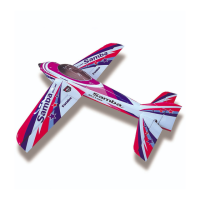4
FlyingPrecautions
DANGER
Takeenoughsafetyprecautionspriortooperatingthis
model.Youareresponsibleforthismodel'sassemblyand
safeoperation.
First-timefliersshouldseekadviceforhintsinpre-
flightadjustmentsandassemblyfromexperiencedfliers.
Beremindedthatflyingabadlyassembledorbadly
adjustedairplaneisverydangerous.
Inthebeginning,first-timefliersshouldalwaysbe
assistedbyanexperiencedflierandneverflyalone.
Beforeflyingyourairplane,ensuretheairfieldis
spaciousenough.Alwaysflyitoutdoorsinsafeareaswith
nodebrisorobstacles.
Ensurethepropelleraresecurelyinstalled.
Donotflyyourairplaneondayswithstrongwindsor
sidewinds.
Donotallowabystandertogettooclosetothe
propeller.
Donotusedefectivepropellers.
Nevergraspthetransmitterantennawhileflying.
■Thetransmitteroutputmaydropdrastically.
Alwaysmakesurethatalltransmitterstickmovements
operateallservosproperlyinthemodelpriortoflight.
Also,makesurethatallswitches,etc.functionproperly
aswell.Ifthereareanydifficulties,donotusethesystem
untilallinputsarefunctioningproperly.
Whileoperating,nevertouchthetransmitterwith,
orbringthetransmitternear,anothertransmitter,a
cellphone,orotherwirelessdevices.
■Doingsomaycauseerroneousoperation.
Donotpointtheantennadirectlytowardtheaircraft
duringflight.
■Theantennaisdirectionalandthetransmitteroutputisweakest.
(Thestrengthoftheradiowavesisgreatestfromthesidesofthe
antenna.)
Neverflyonarainyday,whenthewindisstrong,and
atnight.
■Watercouldleadtofailureorimproperfunctionalityandpoor
controloftheaircraftwhichcouldleadtoacrash.
Neverturnthepowerswitchonandoffduringflightor
whilethemotorisrunning.
■Operationwillbecomeimpossibleandtheaircraftwillcrash.
Evenifthepowerswitchisturnedon,operationwillnotbegin
untiltransmitterandreceiverinternalprocessingiscomplete.
Donotflywhenyouarephysicallyimpairedasitcould
poseasafetyhazardtoyourselforothers.
Donotflyatthefollowingplaces:
■ Nearanotherradiocontrolflyingfield.
■ Nearorabovepeople.
■ Nearhomes,schools,hospitalsairports,roadsorotherplaces
wherepeoplecongregate.
■ Nearhighvoltagelines,highstructures,orcommunication
facilities.
Whensettingthetransmitteronthegroundduring
flightpreparations,donotstanditupright.
■Thetransmittermaytipover,thesticksmaymoveandthe
propellermayrotateunexpectedlyandcauseinjury.
Donottouchthemotor,motorcontrollerduringand
immediatelyafteruse.
■Theseitemsmaybecomehotduringuse.
Forsafety,flysothattheaircraftisvisibleatalltimes.
■Flyingbehindbuildingsorotherlargestructureswillnotonly
causeyoutolosesightoftheaircraft, butalsodegradetheRF
linkperformanceandcauselossofcontrol.
Fromthestandpointofsafety,alwayssetthefailsafe
function.
■Inparticular,normallysetthethrottlechanneltoidle.
Whenflying,alwaysreturnthetransmittersetup
screentotheHomescreen.
■Erroneousinputduringflightisextremelydangerous.
Alwayschecktheremainingcapacityofthetransmitter
andreceiverbatteriesbeforeeachflyingsessionpriorto
flight.
■Lowbatterycapacitywillcauselossofcontrolandacrash.
Alwayscheckoperationofeachcontrolsurfaceand
performarangetestbeforeeachflyingsession.
■ Evenonetransmittersettingoraircraftabnormalitycancausea
crash.
Beforeturningonthetransmitter:
1.Alwaysmovethetransmitterthrottlestickpositiontothe
minimum(idle)position.
2.Turnonthetransmitterfirstandthenthereceiver.
Whenturningoffthetransmitter'spowerswitchafter
themotorhasstopped(stateinwhichitwillnotrotate
again):
1.Turnoffthereceiverpowerswitch.
2.Thenturnoffthetransmitterpowerswitch.
■Ifthepowerswitchisturnedon/offintheoppositeorder,the
propellermayrotateunexpectedlyandcauseaseriousinjury.
■Alsoalwaysobservetheaboveorderwhensettingthefailsafe
function.
■Maximumlowthrottle:Directioninwhichthemotorrunsatthe
slowestspeedorstops.
Whenadjustingthetransmitter,stopthemotor,
disconnectthemotorwiringthatallowsittocontinue
operation.Whendoingso,pleaseexerciseextreme
caution.Ensurethattheaircraftissecuredandthatit
willnotcomeintocontactwithanythingoranyone.
Ensurethatthemotorwillnotrotatepriortomakingany
adjustments.
■Unexpectedhighspeedrotationofthemotormaycausea
seriousinjury.
Thisairframeisnotdesignedtoflyatexcessivelyhigh
speeds.
■Theairplanecouldbecomedamaged.

